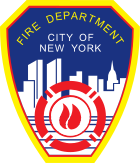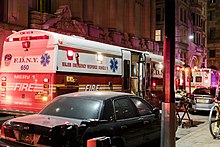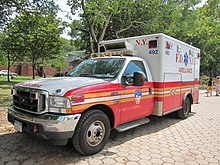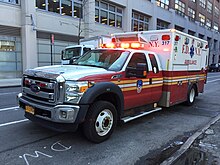
Emergency medical services (EMS), also known as ambulance services or paramedic services, are emergency services that provide urgent pre-hospital treatment and stabilisation for serious illness and injuries and transport to definitive care. They may also be known as a first aid squad, FAST squad, emergency squad, ambulance squad, ambulance corps, life squad or by other initialisms such as EMAS or EMARS.

An emergency medical technician is a medical professional that provides emergency medical services. EMTs are most commonly found serving on ambulances and in fire departments in the US and Canada, as full-time and some part-time departments require their firefighters to be EMT certified.

The New York City Fire Department, officially the Fire Department of the City of New York (FDNY) is the full-service fire department of New York City, serving all five boroughs. The FDNY is responsible for fire suppression and fire prevention, and is a major provider of EMS services in New York City. Beyond fire suppression and EMS, the FDNY is responsible for a broad range of services, including technical rescue, CBRN defense, and structural collapse response and analysis. The FDNY is equipped with a wide variety of general-purpose and specialized Vehicles,Tools and Equipment to serve its varied missions.

A certified first responder is a person who has completed a course and received certification in providing pre-hospital care for medical emergencies. Certified individuals should have received much more instruction than someone who is trained in basic first aid and cardiopulmonary resuscitation (CPR) but they are not necessarily a substitute for more advanced emergency medical care rendered by emergency medical technicians and paramedics. First responders typically provide advanced first aid level care, CPR, and automated external defibrillator (AED) usage. The term "certified first responder" is not to be confused with "first responder", which is a generic term referring to the first medically trained responder to arrive on scene and medically trained telecommunication operators who provide pre-arrival medical instructions as trained Emergency Medical Dispatchers (EMD). Many police officers and firefighters are required to receive training as certified first responders. Advanced medical care is typically provided by EMS, although some police officers and firefighters also train to become emergency medical technicians or paramedics.

Hatzalah is the title used by many Jewish volunteer emergency medical service (EMS) organizations serving mostly areas with Jewish communities around the world, giving free medical service to patients regardless of their religion. Most local branches operate independently of each other, but use the common name. The Hebrew spelling of the name is always the same, but there are many variations in transliteration, such as Hatzolah, Hatzoloh, and Hatzola. It is also often called Chevra Hatzalah, which loosely translates as "Company of Rescuers", "Group of Rescuers", or "Rescue Squad". It is the largest volunteer medical group in the United States.

A nontransporting EMS vehicle is a vehicle that responds to and provides emergency medical services (EMS) without the ability to transport patients. For patients whose condition requires transport, an ambulance is necessary. In some cases they may fulfill other duties when not participating in EMS operations, such as policing or fire suppression.
An emergency service unit (ESU), alternatively emergency service detail (ESD) or emergency service squad (ESS), is a type of unit within an emergency service, usually police, that is capable of responding to and handling a broader or more specific range of emergencies and calls for service than regular units within their organization, such as rescue, emergency management, and mass casualty incidents. They are similar to police tactical units, fire department technical rescue, and incident response teams in other emergency services and organizations, and often have similar or overlapping roles; the term is also used synonymously for these units, or as a catch-all for units that combine multiple disciplines and roles under one banner.

Louisville Metro Emergency Medical Services is the primary provider of pre-hospital life support and emergency care within Louisville-Jefferson County, Kentucky. LMEMS is a governmental department that averages 90,000 calls for service, both emergency and non-emergency, each year.
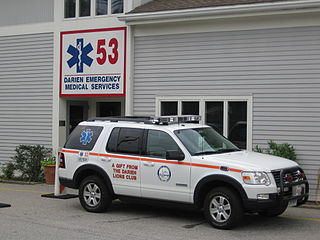
In the United States, emergency medical services (EMS) provide out-of-hospital acute medical care and/or transport to definitive care for those in need. They are regulated at the most basic level by the National Highway Traffic Safety Administration, which sets the minimum standards that all states' EMS providers must meet, and regulated more strictly by individual state governments, which often require higher standards from the services they oversee.
Winnipeg Fire Paramedic Service (WFPS) provides fire and EMS services to the City of Winnipeg, Manitoba. It operates from 27 fire stations, and 3 administration offices across the city.
Boston Emergency Medical Services provides basic life support (BLS) and advanced life support (ALS) ambulance units throughout the neighborhoods in the city of Boston, Massachusetts, USA. Boston EMS is a public safety agency responding to 911 calls alone or with the Boston Police and/or Boston Fire Departments dependent upon the nature of an incident. The agency employs over 400 emergency medical technicians (EMT) and paramedics.
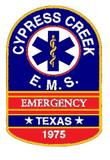
Cypress Creek Emergency Medical ServicesAssociation, also known as Cypress Creek EMS (CCEMS) was a private, non-profit emergency medical service provider for Harris County ESD 11 in North Harris County, within greater Houston, Texas. In 2021, CCEMS declared bankruptcy and operations ceased in mid 2022. In late 2022, the remaining assets, branding, and trademarks were bought by Viking Enterprises, DBA City Ambulance Service. All ambulances in use by CCEMS are Mobile Intensive Care Units (MICU), with at least one Paramedic, making all ambulances ALS units. Cypress Creek EMS provided 911 service in North Harris County, provided bicycle medic teams for special events, provided tactical EMS support for federal, state, and local law enforcement, and operated an accredited educational institution.
Grady EMS is an emergency care provider owned by Grady Healthcare System, established in 1892 in Atlanta, Georgia.

Emergency medical services in Italy currently consist primarily of a combination of volunteer organizations providing ambulance service, supplemented by physicians and nurses who perform all advanced life support (ALS) procedures. The emergency telephone number for emergency medical service in Italy is 118. Since 2017 it has also been possible to call by the European emergency number 112, although this is a general police/fire/medical number.
An advanced emergency medical technician is a provider of emergency medical services in the United States. A transition to this level of training from the emergency medical technician-intermediate, which have somewhat less training, began in 2013 and has been implemented by most states. AEMTs are not intended to deliver definitive medical care in most cases, but rather to augment prehospital critical care and provide rapid on-scene treatment. AEMTs are usually employed in ambulance services, working in conjunction with EMTs and paramedics; however they are also commonly found in fire departments and law enforcement agencies as non-transporting first responders. Ambulances operating at the AEMT level of care are commonplace in rural areas, and occasionally found in larger cities as part of a tiered-response system, but are overall much less common than EMT- and paramedic-level ambulances. The AEMT provides a low-cost, high-benefit option to provide advanced-level care when the paramedic level of care is not feasible. The AEMT is authorized to provide limited advanced life support, which is beyond the scope of an EMT.
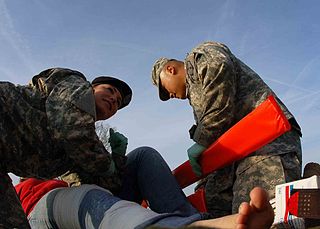
Emergency medical responders are people who are specially trained to provide out-of-hospital care in medical emergencies, typically before the arrival of an ambulance. Specifically used, an Emergency Medical Responder is an EMS certification level used to describe a level of EMS provider below that of an emergency medical technician and paramedic. However, the EMR is not intended to replace the roles of such providers and their wide range of specialties.
Statcom - Citywide MARTA Mission Critical EMS Rescue / Fire Rescue & SecureMobility Transit is the largest private provider of advanced life support (ALS) and basic life support (BLS) ambulance transportation services in the tri-state area. Its main operation areas of New York City, the Hudson Valley, Long Island, the state of Delaware, the Baltimore-Washington DC corridor and in numerous locations in Pennsylvania. It was the largest privately owned ambulance service in the Mid-Atlantic. It was the largest privately owned public benefits corporation ambulance and paratransit service in the Tri-State Area

State Medical Rescue in Poland is a system of free public emergency healthcare established by Ustawa o Państwowym Ratownictwie Medycznym, including ambulance service and Emergency Departments (EDs). While in Polish public hospitals and clinics NFZ common public insurance is required, PRM medical services in ambulances and EDs are completely free for everyone. Since 2018 emergency ambulances that operates in PRM, that is Polish 112 and 999 emergency numbers, are operated by public entities only.
Cataldo Ambulance Service and Atlantic Ambulance Service are a private emergency medical services (EMS) provider in the Greater Boston and North Shore areas of the Commonwealth of Massachusetts, licensed at the advanced life support (ALS) level by the Massachusetts Department of Public Health. As of October 2022, Cataldo had 48 ambulances registered with the state, while the Atlantic division had an additional 45. Headquartered in Somerville, Massachusetts, and with base locations throughout the North Shore, Cataldo provides 911 and interfacility transportation (IFT) ambulance service to several communities, hospitals, and nursing facilities in Massachusetts. Cataldo also operates SmartCare, a mobile integrated health (MIH) provider.
The Virginia Beach Department of Emergency Medical Services is the 911 EMS provider for Virginia Beach, Virginia. Virginia Beach is the largest city in the United States with a volunteer based EMS system. Since the 1940s Virginia Beach has offered free pre-hospital emergency services through 10 volunteer rescue squads supported by 1,100+ volunteers throughout the city. Virginia beach EMS has also been a leader in a variety of pre-hospital technologies including 12-lead transmission,EZ-IO technology and therapeutic hypothermia,rapid sequence induction and intubation (RSII),video laryngoscope,end tidal CO2 monitoring,S T Elevation Myocardial Infarction (STEMI) and Stroke programs and community CardioPulmonary Resuscitation (CPR),among others. These programs and more have contributed to the 36% cardiac arrest survival rate (2012).
